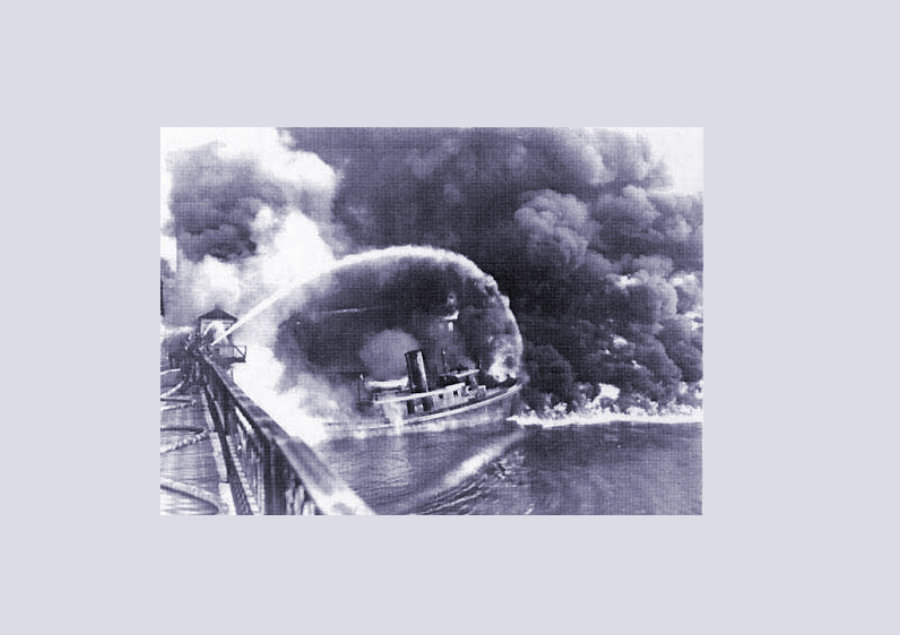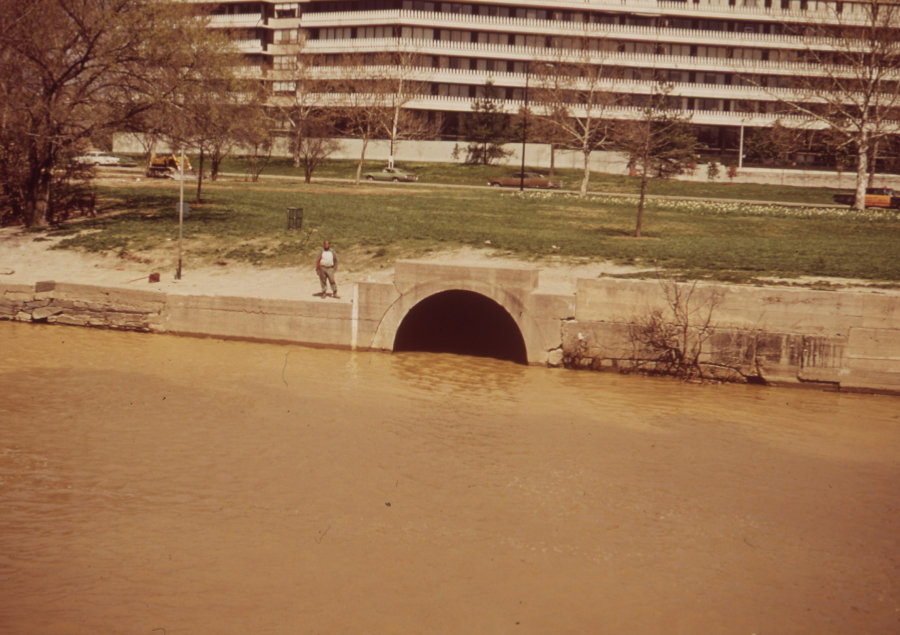Trump’s been adamant from the start of his campaign that, if elected, he’d roll back the ‘disgraceful’ environmental regulations that stifle the national economy. Since then, he’s made good on his promises, repealing or gutting dozens of environmental rules set forth by the Environmental Protection Agency (EPA) and other federal organizations.
But are environmental regulations like the Clean Air Act truly bad for the US economy, overburdening businesses and leaving workers without jobs, as Trump says?
EPA’s raison d’être is environmental protection

This isn’t widely apparent from the EPA’s current actions, but the original purpose of the Environmental Protection Agency was, in fact, to protect the environment.
If there was a single incident that spurred the creation of the EPA in 1970, it was the 1969 fire on the Cuyahoga River near Cleveland, Ohio. After years of sewage and oil pollution into the river, the Cuyahoga was one of the US’ most polluted rivers. On June 22, 1969 sparks from a nearby train ignited oil on the water, causing the river to – quite literally – catch on fire, with flames reportedly up to five stories tall. Amazingly, this wasn’t the first time the river had caught on fire. Since 1868, there had been an incredible 13 incidences.
The fire brought to public attention just how serious water and air pollution can be. Just six months later, on January 1st, 1970, Congress signed the Natural Environmental Policy Act, which established the EPA to manage environmental risks and regulate environmental policies. As part of his presentation to Congress, Nixon laid out a series of environmental goals for the EPA that seems – in hindsight – extremely basic:
- Establish funding for better water treatment facilities
- Create air quality and emissions guidelines
- Launch federally-funded research on car pollution
- Clean up air and water emissions from government facilities
- Set up a plan for treating oil spills
- Create legislation to end waste disposal directly into the Great Lakes
Looking at the list above, it’s almost unbelievable that many of these issues hadn’t come up before (especially that last one).

By and large over the last fifty years, the EPA has focused in and expanded on this list. You don’t even need to leave the capitol to see an example of the EPA’s environmental policies in action – and the ensuing benefits.
By the 1960s, Washington DC had been using the Potomac River as a convenient sewer for over 100 years. By 1969, the city was dumping 240 million gallons of raw sewage into the river daily. President Lyndon Johnson even called the river ‘a national disgrace’.
After the EPA was formed, Congress passed the Clean Water Act, which is administered by the EPA. Under new regulations, the city upgraded sewage plants and placed controls on toxic phosphorus which contributed to the river’s deterioration. Today, after 50 years of ongoing progress, the river is free of algal blooms (a product of pollution) and locals can once again safely boat and fish on the river.
Today, the EPA employs about 14,000 people, most of whom are scientists, engineers, and other environmental specialists, all with the express goal of studying and assessing environmental health, and guiding environmental policy.
The EPA has established many of the human- and earth-friendly policies and programs we all benefit from each and every day. Do you like jogging on your city streets? Thank the Clean Air Act of 1963, which sets air quality and emissions standards so our cities are no longer covered in smog. Do you like not suffering radiation poisoning? The EPA sets rules on nuclear waste management and nuclear power operations. How about clean drinking water and beach visits? Thank the EPA for our clean recreational beaches via the 2000 BEACH Act and safe drinking water through the 1974 Safe Drinking Water Act.
Trump sees the EPA as a hindrance to economic growth
Trump’s rollback of environmental policy should come as no surprise. Yes, environmental regulations increase the health of both the people and the environment of the US, but Trump’s always been very open about his hatred towards the EPA and environmental regulations that he sees as anti-business.
During the 2016 election, when Fox News asked if he would cut departments, Trump replied, “Environmental protection, what they do is a disgrace. Every week they come out with new regulations.” And when Fox asked who would be responsible to protect the environment, the now-president said, “We’ll be fine with the environment. We can leave a little bit, but you can’t destroy businesses.”
As we all know, Barack Obama took a much different approach to environmental concerns. During his presidency, Obama passed a huge swath of regulation designed to protect the environment, including tax credits and financing for clean energy projects, joining 194 other countries in signing the Paris Climate Agreement, increasing standards for car and truck emissions, and creating the Clean Power Plan. It’s that last one, which was designed to combat climate change by lowering CO2 emissions from electricity generation, that caused the most uproarious response.
The issue was two-fold. First, the policy was specifically aimed at combating climate change – a red hot issue in American politics. Second, states and businesses claimed the EPA was overstepping its responsibilities with the CPP, specifically around section 111(d), which required every state to reduce emissions by 32% of 2005 levels by 2030. Twenty-nine states immediately sued the EPA, on the grounds the plan was unconstitutional.
Trump rolls back Obama-era policy
After the election, Trump got to work dismantling many of the environmental policies signed into law by Obama and previous presidents, including the Clean Power Plan.
In 2017, Trump signed an executive order calling for the EPA to review the plan. At that time, Trump said, “We’re ending intrusive EPA regulations that kill jobs, hurt family farmers and ranchers, and raise the price of energy so quickly and so substantially.” In October later that year, the EPA announced it was planning to end the Clean Power Plan and fill the gap left with a dubious replacement, the Affordable Clean Energy Act, which scientists warn could possibly lead to even more emissions in certain states.
Since Trump’s taken office, he’s rolled back 47 environmental regulations, with another 31 in progress, according to the NY Times. Most involve the EPA. Beyond the CPP rollback, here’s a few more:
- Cancelling a requirement that oil and gas companies must report methane emissions
- No longer enforcing a ban on hydrofluorocarbons in AC and refrigerators
- Moved to a weaker pollution permitting program for new power plants
- Rewriting an Obama-era rule to reduce air pollution in national parks
- Proposed weakening Obama-era fuel economy standards for cars and trucks
- Proposed eliminating a program to limit lead exposure
Under Trump, the EPA is now waging a war against both federal regulations that he says overburden businesses as well as the idea of climate change period, along with any regulations designed specifically to address it – an unthinkable predicament just a few years ago.
After former EPA Administrator Scott Pruitt praised Trump’s ‘courage and leadership’ towards environmental regulation in the EPA’s 2017-2018 Year in Review, the report continues “In recent years, however, EPA expanded its authority and jurisdiction into areas outside its core mission. In the process, central responsibilities of the Agency took a backseat to ideological crusades, allowing some environmental threats – like cleaning up toxic land – to go unaddressed.”
Since Trump was elected, the Washington Post reported that 1,600 employees have voluntarily left the EPA, feeling their time would be better spent elsewhere.
Trump’s current pick to head the EPA, Andrew R Wheeler, is a former lobbyist representing Robert E Murray, CEO of one of the largest coal mine operators in the US. During his decade or so as a lobbyist, Wheeler fought against Obama’s environmental regulations as well as for protections for the coal industry, which has been in steady decline since the 1990s as utilities turned to cheaper, cleaner-burning natural gas.
Are environmental regulations job-killers?

So we can thank the EPA for our clean air and water, but are the regulations it passes truly burdening the US economy, as Trump says?
In an article on this very topic, The Atlantic notes that, while clean air and water regulations can cause job loss on a local level (as a coal plant closes, for example), there’s no evidence that environmental regulations hamper the economy on a larger scale. As one polluting plant or business closes down, another pops up to takes its place.
As part of a 2013 study, economist Richard Morgenstern (formerly of the EPA) looked at 30 years of employment statistics in the oil, plastic, paper, and steel industry, and found that these industries, despite increasing regulation over that time, saw ‘insignificant’ changes in employment numbers. However, as shown by a 2015 study in the Journal of Benefit Cost Analysis, environmental regulations can necessitate workers moving to another area, which can be a costly expenditure. For example, a coal plant closes and the workers move to an area with a natural gas or wind farm with available positions.
In a 2013 paper, economist W. Reed Walker found that the overall benefits of environmental policies largely outweigh the costs. After Congress updated the Clean Air Act 1990, Walker writes, the average electricity plant worker lost 20% of her income, typically after leaving a current position and moving to another company. In total, this worked out to a total loss of $5.4 billion.
The EPA though estimates the amendments led to a $160 billion to $1.6 trillion in health benefits, mostly thanks to lower premature and adult mortality, fewer lost work days, less asthma and bronchitis, and fewer emergency room benefits.
The author sums up his findings, saying “The arguments supporting environmental regulations point to increasing evidence that benefits from environmental policy far exceed the costs. The findings in this study do not contradict this logic; the wage costs borne by workers are a small fraction of the estimated benefits.”
Earthtechling’s breakdown of the situation
We can sum up regulation’s effect on the economy as such: Yes, there is some localized job loss, which can truly uproot an entire family, but overall research shows that regulation has a minuscule effect on national job numbers and an overall positive effect on the economy, though many of those benefits are intangible – cleaner air and water that allows us to go to work more regularly, avoid health issues, and simply enjoy our lives more fully.
Trump intelligently poses this whole issue not as environmental protection vs the economy – who would be against clean water and air? – but as government overreach vs the economy.
However, in rolling back the policies that constitute this ‘overreach’, he’s also dismantling the laws and rules that stand to make the US a cleaner, safer place to live in the future. Of course, in any bureaucracy there will be far too many regulations, many of which could be dismantled. But at this point – with the repeal of the Clean Power Plan, the backing out of the Paris Climate Agreement, the removal of more stringent car emissions standards – the US is in jeopardy of throwing out the baby with the bathwater.
These are the regulations that allow us to fish and boat local rivers like the Cuyahoga, go jogging on city paths in Central Park, and swim on Florida beaches. If you enjoy working, playing, and traveling in the US, then you’re enjoying the EPA’s regulations.
Image Sources: CC license via Wikimedia Commons – 1, 2, 3 and Public Domain via Flickr